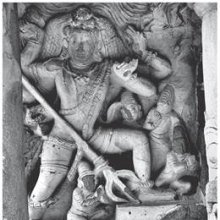Mise: 3 definitions
Introduction:
Mise means something in the history of ancient India, biology. If you want to know the exact meaning, history, etymology or English translation of this term then check out the descriptions on this page. Add your comment or reference to a book if you want to contribute to this summary article.
Images (photo gallery)
India history and geography
Source: Project Gutenberg: Castes and Tribes of Southern India, Volume 1Mise (“moustache”) is one of the exogamous septs (divisions) among the Kurubas (a tribe of South India). The Kurubas are sub-divided into clans or gumpus, each having a headman or guru called a gaudu, who gives his name to the clan. And the clans are again sub-divided into gotras or septs (viz., Mise).

The history of India traces the identification of countries, villages, towns and other regions of India, as well as mythology, zoology, royal dynasties, rulers, tribes, local festivities and traditions and regional languages. Ancient India enjoyed religious freedom and encourages the path of Dharma, a concept common to Buddhism, Hinduism, and Jainism.
Biology (plants and animals)
Source: Google Books: CRC World Dictionary (Regional names)Mise in Togo is the name of a plant defined with Pennisetum glaucum in various botanical sources. This page contains potential references in Ayurveda, modern medicine, and other folk traditions or local practices It has the synonym Panicum holcoides Jacq. (among others).
Example references for further research on medicinal uses or toxicity (see latin names for full list):
· Linnaea (1853)
· Feddes Repert. (1973)
· Grasses of Ceylon (1956)
· Acta Biol. Cracov., Ser. Bot. (1982)
· Revisio Generum Plantarum (1891)
· A Manual of Botany (1840)
If you are looking for specific details regarding Mise, for example health benefits, chemical composition, side effects, diet and recipes, extract dosage, pregnancy safety, have a look at these references.

This sections includes definitions from the five kingdoms of living things: Animals, Plants, Fungi, Protists and Monera. It will include both the official binomial nomenclature (scientific names usually in Latin) as well as regional spellings and variants.
Languages of India and abroad
Kannada-English dictionary
Source: Alar: Kannada-English corpusMīse (ಮೀಸೆ):—
1) [noun] the hair that a man has let grow out on his upper lip; moustache.
2) [noun] ಮೀಸೆ ಬೋಳಿಸು [mise bolisu] mīse bōḷisu to shave one’s moustache accepting one’s defeat; ಮೀಸೆ ಮಣ್ಣಾಗು [mise mannagu] mīsi maṇṇāgu to be dishonoured, humiliated; ಮೀಸೆ ಇಳಿಬಿಡು [mise ilibidu] mīse iḷibiḍu to become humble; to lose one’s courage, vigour;ಮೀಸೆ ತಿಕ್ಕು [mise tikku] mīse tikku to trim one’s moustache; ಮೀಸೆ ತಿರುವು [mise tiruvu] mīse tiruvu = ಮೀಸೆ ತಿರುಗಿಸು [mise tirugisu]; ಮೀಸೆ ಹುರಿಮಾಡು [mise hurimadu] mīse hurimāḍu = ಮೀಸೆ ತಿರುಗಿಸು [mise tirugisu]; ಅಂಬಲಿ ಕುಡಿಯುವವನಿಗೆ ಮೀಸೆ ತಿಕ್ಕುವವನೊಬ್ಬ [ambali kudiyuvavanige mise tikkuvavanobba]; ambali kuḍiyuvavanige mīsi tikkuvavanobba (prov.) he, who begs for his food, needs a train of assistants (to show is no inferior); ಮೀಸೆ ತಿರುಗಿಸು [mise tirugisu] mīse tirugisu to turn and twist the either terminals of the moustache in anger or arrogance; ಮೀಸೆಯ ಮೇಲೆ ಕೈ ಹಾಕು [miseya mele kai haku] mīseya mēle kai hāku = ಮೀಸೆ ತಿರುಗಿಸು [mise tirugisu].
Kannada is a Dravidian language (as opposed to the Indo-European language family) mainly spoken in the southwestern region of India.
See also (Relevant definitions)
Starts with: Misegadi, Misegara, Misemy, Misery Contemplation.
Ends with (+15): Aafimise, Ako kini aafimise, Caurimise, Chamise, Chyasamise, Cigurumise, Common chamise, Cumcumise, Domdimise, Galamise, Gallamise, Gallimise, Giralumise, Girijamise, Girlumise, Gujurumise, Hulimise, Jhisamise, Jumjumise, Kalefimise.
Full-text (+1): Ijugara, Sodaratte, Dikkata, Satyapratijna, Dikata, Duragraha, Adesa, Duragrah, Ambali, Gulakhobarem, Ekavacana, Ravanana-mise, Jatti, Ravana, Gumana, Abhyasa, Khau, Abhinaya, Naraka, Ishu.
Relevant text
Search found 4 books and stories containing Mise, Mīse; (plurals include: Mises, Mīses). You can also click to the full overview containing English textual excerpts. Below are direct links for the most relevant articles:
Trishashti Shalaka Purusha Caritra (by Helen M. Johnson)
Part 9: Description of Airāvaṇa < [Chapter III]
The Buddhist Philosophy of Universal Flux (by Satkari Mookerjee)
Chapter XIV - A Critical Estimate of the Non-soul Theory of the Buddhist Philosophers < [Part I - Metaphysics]
The Mahavastu (great story) (by J. J. Jones)
Kathasaritsagara (the Ocean of Story) (by Somadeva)
